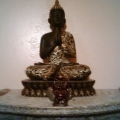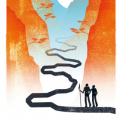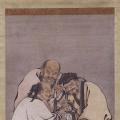Awareness of Breath
 QuangKsanti
A human residing in Hamilton, Ontario, Canada. The Hammer in Ontario, Canada, eh Veteran
QuangKsanti
A human residing in Hamilton, Ontario, Canada. The Hammer in Ontario, Canada, eh Veteran
Hello, dear friends on the Path;
It's been a spell since I've been on but we've shared a lot over the years and there is a lot of insight on this site. Hope everybody is doing alright. This is a bit longer so don't feel bad if it's one of those tldr deals.
In September, I started a 3-5 year Dharma Teachers course which will see me ordained as a Zen Buddhist Priest. After that, I'll add Chaplaincy. I've taken the Five Mindfulness Trainings in the Plum Village Tradition and the Bodhisattva Precepts with my current Zen Tradition and this feels like the natural next step.
As part of said course there are a few essays I have to write. I just finished one on the Awareness of Breathing and I just wanted to share it here in case it helps anyone or in case anyone has any feedback. Not to worry, I've already handed it in so I can't edit any more.
Was just thinking of you guys is all.
The Awareness of Breathing Meditation
Breathing in, I am beginning to type. Breathing out, I am going to enjoy writing this essay. Within, I use the guidance from the Anapanasati Sutta along with the Venerable Thich Nhat Hanh's commentary in the book, “Breathe… You are Alive” as well as what I
have learned from my teacher the Venerable
Bhikkuni Thich nu Tinh Quang.
Breathing meditation is a practice recommended by the Buddha to ground us in the present moment and help us to awaken. The breath happens whether we think about it or not. Whether we notice it or not. However, when we do notice it and pay attention to
it, we can be more easily aware of everything else.
I was lucky to have attended a Vipassana
Meditation course and the first of seven weeks was centered around the Mindfulness of Breathing. I learned that there is so much more to breathing meditation than solely the breath, however, it can be our natural anchor because it is always with us which means we can use it at any time to remind and help us to be more aware and bring us back to the present moment. When we bring conscious
attention to the breath, a whole world of awareness opens up.
When we catch ourselves getting carried away by thought we can then go back to the breath. Catching ourselves making distracting storylines is the trick. Once we notice, we have already broken the spell and the more we notice, the easier it gets to notice.
Although it may seem repetitive, returning to the breath again and again gradually develops
concentration and helps us let go of the incessant need to identify with the thought stream.
Because we often overlook the natural rhythm and flow of the breath, we don’t see how it can act as a tether between body and mind and thus, the present moment. Through the awareness of breathing, we can be more focused and thus more aware of the subtle changes in our body, mind and the environment we are not separate from.
Our monkey mind wants to swing from branch to branch, from thought to thought. Thoughts arise depending on conditions, just like everything else, and in turn, they condition what follows. When we see we are going off on a tangent, just this realization is enough to snap out of it and go back to the breath. We can train our monkey.
When we use the words “breathing in, I am aware of (whatever we happen to be doing or noticing)” it leaves no alternate branches to swing to. There is no room for worries about yesterday or tomorrow and so it steers the monkey into an ideal direction. It takes our current conditioning into our own hands.
Thich Nhat Hanh said that during walking
meditation, when we are inside we can take a
breath with every step and when we are outside with others around us we can take two or even three steps with every breath. In, in, in... Out, out, out... Long, long, long... Short, short, short. In this way, we are using the breath as a bridge to call attention to the walking. Then, like the raft on the far shore, we can abandon the words when they become
automatic or second nature and there is just the breath. We are not trying to control the breath, only noticing and paying attention to the quality.
For the Awareness of Breath in the Body Meditation, it is usually recommended we start at the top of the head and slowly work our way down to the feet. Before I started writing this paper, that is how I always did it. Lately, however, I’ve experimented with starting at the lungs and radiating awareness
outward. It has been helping me to stay rooted in the function of the breath itself while strengthening my concentration and, in turn, my compassion. It is also helping me write this essay from my own perspective.
I like to start with my lungs and move out from there. Every part of the body is nourished by the breath and this is obviously especially true for the lungs. Breathing feeds our cells oxygen, helping to build energy. Cellular respiration is our cells using oxygen to convert food to energy. Red blood cells armed with the hemoglobin protein carry oxygen to tissues and organs and carry the carbon dioxide waste away to be exhaled. This gas exchange happens during the circulation between the lungs and the heart which is why I start the awareness of body with the lungs, radiate awareness from there and end with the heart. After scanning the lungs, I move
outward to the stomach and other organs, then my pelvic area. Just looking for anything that needs attention. Any pains, tiredness, itchiness… Anything, really. I acknowledge it and give a compassionate and mindful hug. From there I move to the arms, legs, hands and feet. Then it’s up to the face, mouth, nose, ears, eyes and then the brain. We have an electrical spark in both the brain and the heart so next I go to the heart which figuratively completes the respiratory cycle between inhalation and exhalation.
After going through the various parts of the body, I can then move into the awareness of breath in feelings. With mindful breathing, I can begin to notice whether the sensations in the body and/or mind are pleasant, unpleasant or neutral. This noticing is done without judgement and without adding a storyline. If I feel warmth, tiredness or even
joy, I simply label it as positive, negative or
indifferent and let it go. Observing feelings in this way without judgement, and the reaction that follows closely behind, can bring clarity and allow the feeling to go as it came without attaching to it or the need to react to it. It can just pass through like a cloud in the sky.
This kind of gentle, non-reactive awareness
reinforces the old adage that says “while pain is inevitable, suffering is optional”. In the Buddha’s teaching on the two arrows, the first arrow represents the unavoidable pain that life brings and the second arrow is the one we wound ourselves with through judgements and storylines. With mindful breathing and awareness of feelings, we learn not to shoot that second arrow. We can choose compassion instead.
Breathing in, I am aware of the seed of anxiety being watered. Breathing out, I water the seed of compassion to sprout and be with the anxiety. Breathing in, a light shines on anxiety. Breathing out, anxiety is transformed to well-being.
Sometimes a feeling is very strong. We might attach to it very quickly and it can become a mental formation before we realize it’s happening. Thoughts and feelings arise all the time in our experience and once we begin to cling to them or weave a story around them, they become mental formations.
The conditions arise for anger to manifest and it does. This is just an emotional reaction. Once we begin to think “I’m always doing this” or “Nobody gets me” we start creating a story and now a momentary feeling gains weight and becomes a mental formation and can condition our future experience and interactions. In this way a small reaction can become a big problem and cause a lot of suffering.
Mindfulness of breathing allows us to witness this process as it unfolds. With the breath as our anchor, we can observe the formation arising without being swept away. Without identifying with it. Breathing in, we recognize it; breathing out, we release the need to form a self. In this way, the breath gives us the
spaciousness to let go.
Thich Nhat Hanh also reminds us that it is helpful to be grateful for what we are not suffering. For example, if we have a headache, it is easy to attend to it because of the constant reminder. But when we don’t have a headache, we don’t often think to be grateful for the headache not manifesting.
When we no longer identify with mental formations, we free ourselves to notice not only what hurts, but also what doesn’t. The absence of pain is often invisible. With mindfulness, it becomes a blessing.
When we consciously breathe, we are inviting
ourselves to be present. We are becoming attuned to the sensations in our body, the thoughts that come and go and the emotions that follows shortly after. We are not trying to force anything to change, we are just here to observe. We are nurturing a sense of spaciousness within ourselves, allowing
thoughts and feelings to come and go without
resistance. Change happens gracefully here, with no more effort than it takes to breathe.
In my practice, I find that beginning the day with mindful breathing sets a tone of calm and gratitude. No matter what challenges arise, the breath is always available as a refuge. This hits home daily and is only getting more profound even with the writing of this essay. I can feel the usual patterns of thought and worry being left behind as I cultivate a
deeper connection with myself in, and as, the
world.
Breathing in, I recognize the gift of being alive.
Breathing out, I smile to the world within and around me.
-Quang Ksanti








Comments
I found some useful reminders about the awareness of breath in the essay, that was good. At the same time, I feel it is missing a certain poetry… the breath is one of the glories of the body, and to communicate the beauty of it needs a poetic quality. Maybe a tip for next time? 🙏
In my practice,
I find that beginning
the day
with mindful breathing
sets
a tone
of calm
and gratitude.
No matter what challenges
arise, the breath
is always available
as a refuge.
This hits home
daily and is only
getting more profound
even
with the writing of this essay.
I can feel
the usual patterns of thought
and worry being left
behind as I cultivate a
deeper connection
with myself in, and as, the
world.
Breathing in, I recognize the gift of being alive.
Breathing out, I smile to the world within and around me.
-Quang Ksanti (the poet of the breath)
What a journey! Thanks for sharing The royal breath like Ajahn Sona at the start one of his books... "Bloom, 2020" I think!
The royal breath like Ajahn Sona at the start one of his books... "Bloom, 2020" I think!
David: what wonderful news and what a wonderful path! Keep us posted!
Probably writing another thesis, hugging another greengage tree or pretending only peace for the Haven dwelling...
These fakir Buddhists are no longer helping my transition to COE (Church Of England or is it Chavs Of Empathy?)
The Self-Congratulating Fruit
It is related in the family of the Jan Fishanis that a certain Emir, attended by a substantial retinue, journeyed from Arabia to see the great Khan. When he arrived, he was treated with honour and given costly presents. Many of the court of Jan Fishan expected that after such a journey the prince would ask innumerable questions, or else remain mute and try to absorb wisdom through companionship with the great Khan.
But the Khan said, just before the Emir was ceremonially announced, ‘Watch this interchange, for it is only rarely that one experiences such a thing.’
The Emir entered and said:
‘Confirm me in my Emirate, for I am not of the Family of the Hashimites, and it is from your ancestors that all nobility receives its rank.’
Jan Fishan said:
‘Do you wish ceremony and courtesy and the verification of rank, or do you seek an answer to a question?’
‘Would that I could have both, but if only one is to be given, I desire an answer to my question,’ said the Emir.
‘Since you have asked, with absence of greed, for only one, I shall give you both,’ said Jan Fishan Khan, ‘and I shall confirm or deny your title in the answer to your philosophical question.’
The Emir asked:
‘This is my question. Why do so many Sufis make light of the great deeds, the heroism, the patience and high-mindedness which is the heritage and the glory of the Arab?’
Jan Fishan said:
‘And here is the answer, which will not only explain our position but will also show you your own true position as a nobleman among the Arabs.
‘We discount, and we even deride at times, the qualities upon which so many men pride themselves because those very qualities should be the minimum, not the maximum, attainable by man. If a man is a hero, or a patient one, or devout, or hospitable, or has any of the other qualities – this is the point from which he starts. Is he a beast, that he should be proud if he learns to conduct himself well in relation to others? Is he a fruit, that people should remember his name and always seek others of the same type? No, he is someone who should be ashamed that he has not always been worthy, and should be grateful that he is capable of great things.’
After this the nobleman abandoned the title of Emir, saying, ‘Emir is the word we use for the kind of man who is at the bottom, so why should I need it to describe me? What we call an ordinary man, with few qualities, is not even to be counted in the Journey until he rises to what we call “Highness” (elevated).’
One of his companions said:
‘What! Will you cast aside the glory of your family for something which you could have read in a book?’
The Emir said:
‘I could have read it in a book, and it would have been no less true. Perhaps I have, indeed, read it in a book at some time, but I did not heed it. And, if I have in fact at some time read it, then I am doubly blameworthy, for I have betrayed my literacy through ignoring its value to me in helping me to change back to the status of man, from the status of a self-congratulating fruit.’
The Magic Monastery
Available in Paperback, eBook and Audiobook formats. You can read it for free, or purchase it, here:
https://idriesshahfoundation.org/books/the-magic-monastery